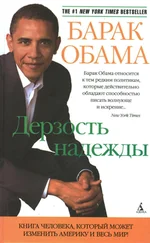Барак Обама - The Audacity of Hope
Здесь есть возможность читать онлайн «Барак Обама - The Audacity of Hope» весь текст электронной книги совершенно бесплатно (целиком полную версию без сокращений). В некоторых случаях можно слушать аудио, скачать через торрент в формате fb2 и присутствует краткое содержание. Жанр: Политика, на английском языке. Описание произведения, (предисловие) а так же отзывы посетителей доступны на портале библиотеки ЛибКат.
- Название:The Audacity of Hope
- Автор:
- Жанр:
- Год:неизвестен
- ISBN:нет данных
- Рейтинг книги:5 / 5. Голосов: 1
-
Избранное:Добавить в избранное
- Отзывы:
-
Ваша оценка:
- 100
- 1
- 2
- 3
- 4
- 5
The Audacity of Hope: краткое содержание, описание и аннотация
Предлагаем к чтению аннотацию, описание, краткое содержание или предисловие (зависит от того, что написал сам автор книги «The Audacity of Hope»). Если вы не нашли необходимую информацию о книге — напишите в комментариях, мы постараемся отыскать её.
The Audacity of Hope — читать онлайн бесплатно полную книгу (весь текст) целиком
Ниже представлен текст книги, разбитый по страницам. Система сохранения места последней прочитанной страницы, позволяет с удобством читать онлайн бесплатно книгу «The Audacity of Hope», без необходимости каждый раз заново искать на чём Вы остановились. Поставьте закладку, и сможете в любой момент перейти на страницу, на которой закончили чтение.
Интервал:
Закладка:
Six months after Michelle and I met, her father died suddenly of complications after a kidney operation. I flew back to Chicago and stood at his gravesite, Michelle’s head on my shoulder. As the casket was lowered, I promised Frasier Robinson that I would take care of his girl. I realized that in some unspoken, still tentative way, she and I were already becoming a family.
THERE’S A LOT of talk these days about the decline of the American family. Social conservatives claim that the traditional family is under assault from Hollywood movies and gay pride parades. Liberals point to the economic factors — from stagnating wages to inadequate day care — that have put families under increasing duress. Our popular culture feeds the alarm, with tales of women consigned to permanent singlehood, men unwilling to make lasting commitments, and teens engaged in endless sexual escapades. Nothing seems settled, as it was in the past; our roles and relationships all feel up for grabs.
Given this hand-wringing, it may be helpful to step back and remind ourselves that the institution of marriage isn’t disappearing anytime soon. While it’s true that marriage rates have declined steadily since the 1950s, some of the decline is a result of more Americans delaying marriage to pursue an education or establish a career; by the age of forty-five, 89 percent of women and 83 percent of men will have tied the knot at least once. Married couples continue to head 67 percent of American families, and the vast majority of Americans still consider marriage to be the best foundation for personal intimacy, economic stability, and child rearing.
Still, there’s no denying that the nature of the family has changed over the last fifty years. Although divorce rates have declined by 21 percent since their peak in the late seventies and early eighties, half of all first marriages still end in divorce. Compared to our grandparents, we’re more tolerant of premarital sex, more likely to cohabit, and more likely to live alone. We’re also far more likely to be raising children in nontraditional households; 60 percent of all divorces involve children, 33 percent of all children are born out of wedlock, and 34 percent of children don’t live with their biological fathers.
These trends are particularly acute in the African American community, where it’s fair to say that the nuclear family is on the verge of collapse. Since 1950, the marriage rate for black women has plummeted from 62 percent to 36 percent. Between 1960 and 1995, the number of African American children living with two married parents dropped by more than half; today 54 percent of all African American children live in single-parent households, compared to about 23 percent of all white children.
For adults, at least, the effect of these changes is a mixed bag. Research suggests that on average, married couples live healthier, wealthier, and happier lives, but no one claims that men and women benefit from being trapped in bad or abusive marriages. Certainly the decision of increasing numbers of Americans to delay marriage makes sense; not only does today’s information economy demand more time in school, but studies show that couples who wait until their late twenties or thirties to get married are more likely to stay married than those who marry young.
Whatever the effect on adults, though, these trends haven’t been so good for our children. Many single moms — including the one who raised me — do a heroic job on behalf of their kids. Still, children living with single mothers are five times more likely to be poor than children in two-parent households. Children in single-parent homes are also more likely to drop out of school and become teen parents, even when income is factored out. And the evidence suggests that on average, children who live with both their biological mother and father do better than those who live in stepfamilies or with cohabiting partners.
In light of these facts, policies that strengthen marriage for those who choose it and that discourage unintended births outside of marriage are sensible goals to pursue. For example, most people agree that neither federal welfare programs nor the tax code should penalize married couples; those aspects of welfare reform enacted under Clinton and those elements of the Bush tax plan that reduced the marriage penalty enjoy strong bipartisan support.
The same goes for teen pregnancy prevention. Everyone agrees that teen pregnancies place both mother and child at risk for all sorts of problems. Since 1990, the teen pregnancy rate has dropped by 28 percent, an unadulterated piece of good news. But teens still account for almost a quarter of out-of-wedlock births, and teen mothers are more likely to have additional out-of-wedlock births as they get older. Community-based programs that have a proven track record in preventing unwanted pregnancies — both by encouraging abstinence and by promoting the proper use of contraception — deserve broad support.
Finally, preliminary research shows that marriage education workshops can make a real difference in helping married couples stay together and in encouraging unmarried couples who are living together to form a more lasting bond. Expanding access to such services to low-income couples, perhaps in concert with job training and placement, medical coverage, and other services already available, should be something everybody can agree on.
But for many social conservatives, these commonsense approaches don’t go far enough. They want a return to a bygone era, in which sexuality outside of marriage was subject to both punishment and shame, obtaining a divorce was far more difficult, and marriage offered not merely personal fulfillment but also well-defined social roles for men and for women. In their view, any government policy that appears to reward or even express neutrality toward what they consider to be immoral behavior — whether providing birth control to young people, abortion services to women, welfare support for unwed mothers, or legal recognition of same-sex unions — inherently devalues the marital bond. Such policies take us one step closer, the argument goes, to a brave new world in which gender differences have been erased, sex is purely recreational, marriage is disposable, motherhood is an inconvenience, and civilization itself rests on shifting sands.
I understand the impulse to restore a sense of order to a culture that’s constantly in flux. And I certainly appreciate the desire of parents to shield their children from values they consider unwholesome; it’s a feeling I often share when I listen to the lyrics of songs on the radio.
But all in all, I have little sympathy for those who would enlist the government in the task of enforcing sexual morality. Like most Americans, I consider decisions about sex, marriage, divorce, and childbearing to be highly personal — at the very core of our system of individual liberty. Where such personal decisions raise the prospect of significant harm to others — as is true with child abuse, incest, bigamy, domestic violence, or failure to pay child support — society has a right and duty to step in. (Those who believe in the personhood of the fetus would put abortion in this category.) Beyond that, I have no interest in seeing the president, Congress, or a government bureaucracy regulating what goes on in America’s bedrooms.
Moreover, I don’t believe we strengthen the family by bullying or coercing people into the relationships we think are best for them — or by punishing those who fail to meet our standards of sexual propriety. I want to encourage young people to show more reverence toward sex and intimacy, and I applaud parents, congregations, and community programs that transmit that message. But I’m not willing to consign a teenage girl to a lifetime of struggle because of lack of access to birth control. I want couples to understand the value of commitment and the sacrifices marriage entails. But I’m not willing to use the force of law to keep couples together regardless of their personal circumstances.
Читать дальшеИнтервал:
Закладка:
Похожие книги на «The Audacity of Hope»
Представляем Вашему вниманию похожие книги на «The Audacity of Hope» списком для выбора. Мы отобрали схожую по названию и смыслу литературу в надежде предоставить читателям больше вариантов отыскать новые, интересные, ещё непрочитанные произведения.
Обсуждение, отзывы о книге «The Audacity of Hope» и просто собственные мнения читателей. Оставьте ваши комментарии, напишите, что Вы думаете о произведении, его смысле или главных героях. Укажите что конкретно понравилось, а что нет, и почему Вы так считаете.

![Барак Обама - Дерзость надежды. Мысли об возрождении американской мечты [The Audacity of Hope]](/books/26630/barak-obama-derzost-nadezhdy-mysli-ob-vozrozhdenii-thumb.webp)










